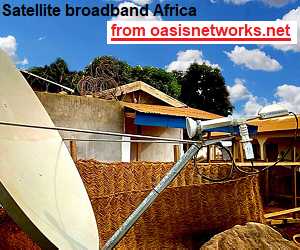Satellite dishes rely on electromagnetic signals to communicate with Earth and orbiting satellites to provide services such as television broadcasts, Internet connectivity, and GPS navigation. Typically, signals operate within specific frequency bands, including the 12-18 GHz Ku-band for television or the 26.5-40 GHz Ka-band for high-speed data. This is obviously due to the fact that the power of DTH Ku-band signals is usually 10-100 watts, so they can cover a large area. Another band, Ka-band, supports faster data transmission rates of up to 50 Mbps, which is essential for Internet services. It is important to properly align the satellite dish with the specific frequency band to ensure minimal signal loss, allowing for efficient transmission and reception.
The design and geometry of the antenna play a critical role in signal quality. A typical parabolic antenna has high gain, easily exceeding 35 dB for Ku-band signals, which enables it to amplify very weak signals from satellites thousands of kilometers away. Reception is best if the signal path between the antenna and the satellite remains within line of sight and free of obstructions such as buildings or trees. A slight mismatch of just 1 degree can result in a loss of up to 10-20% in signal strength, which can directly impact internet speeds or TV clarity. As a result, installations often require antennas with narrower beamwidths, and rural installations are best served with larger antennas that can capture weaker signals.
Weather conditions can also affect the transmission and reception of signals. This phenomenon is called rain fade, and heavy rainfall can weaken high-frequency signals such as Ka-band, causing up to 10 dB of signal strength loss. To combat this, service providers typically install some kind of adaptive power control system on the satellite that increases the transmission power to compensate for rain fade. For example, during a storm, Ka-band internet service speeds may drop from 50 Mbps to 30 Mbps, while Ku-band signals typically only lose around 3-5 Mbps under similar conditions. In areas with more rainfall, the largest dish antenna will always benefit home users, as a 90 cm dish antenna will perform better than a 60 cm dish antenna in inclement weather.

The most common and effective satellite antenna design is the parabolic dish, primarily because it focuses electromagnetic waves to a single point to maximize the signal. These antennas work by reflecting incoming satellite signals off a feed horn located at the focal point. A typical parabolic dish has a gain of about 35 to 45 dB at Ku-band frequencies and up to 55 dB at Ka-band frequencies, depending on size. For example, a 1.2-meter antenna operating in the Ku-band provides about 40 dB of gain, enabling clear reception of signals from satellites 35,000 kilometers away.
The size of a parabolic dish directly determines its performance. Larger antennas provide narrower beamwidths, which minimize interference from nearby satellites and terrestrial signals. For example, a 90-cm antenna typically has a beamwidth of about 1.5 degrees, while a 1.8-meter antenna reduces that to about 0.75 degrees. This improvement is critical for applications that require high accuracy, such as when transmitting data over dense constellations of satellites. However, larger antennas are more sensitive to environmental factors such as wind and are therefore equipped with robust mounting systems to maintain alignment.
Material selection is also an important factor in designing parabolic antennas. Most antennas are made of aluminum, which is both light and reflective. For example, an aluminum antenna with a surface accuracy of 0.5 mm will have the best signal reflection at frequencies up to 40 GHz used in Ka-band services. Large antennas designed for scientific applications may use carbon fiber composites to reduce thermal expansion and maintain surface accuracy despite temperature fluctuations. With such materials, the antenna can achieve the high gain required for applications such as deep space communications.
2. Frequency conversion
Frequency conversion in satellite communications is a critical process that enables signals to be efficiently sent over long distances and processed by ground equipment. Satellites use high frequencies, ranging from 12 to 18 GHz in the Ku-band and 26.5 to 40 GHz in the Ka-band, to minimize interference and enable high data rates. However, all of these frequencies are not suitable for direct use by ground receivers, so satellite antennas use frequency converters to step them down to an intermediate frequency range, typically 950 MHz to 2150 MHz. This conversion enables the signal to be transmitted over standard coaxial cable with minimal loss.
The LNB converter mounted on the dish is responsible for the frequency conversion. Modern LNBs have noise figures as low as 0.3 dB, which is much clearer than older models with noise figures as high as 0.7 dB. For example, an LNB operating in the Ka-band can amplify a weak satellite signal from -130 dBm to a level suitable for ground processing while simultaneously stepping the frequency down from 30 GHz to a manageable IF. This feature is critical for high-definition television broadcasts and high-speed internet services as it allows signals to be transmitted with minimal attenuation.
Frequency conversion is also critical to reducing signal interference between multiple signals. Satellites operate by separating uplink and downlink signals using FDM. For example, in the Ku band, uplink frequencies operate in the 14-14.5 GHz range while downlink frequencies operate in the 11.7-12.2 GHz range. The LNB converts these high frequencies to IF for set-top box or modem compatibility. This ensures that there is no signal overlap between uplink and downlink; thereby ensuring quality communications. Lack of accurate frequency conversion can result in distorted or lost signals, which can severely impact services such as live streaming and video conferencing.
3. Propagation Path
Satellite antennas require a clear line of sight to establish a stable connection with satellites in orbit. Antennas must have a clear path to the satellites because even small obstacles such as trees or buildings can weaken or completely block the signal. For example, obstructions can cause up to 15 dB of signal loss, which is extremely detrimental to the quality of service for applications such as satellite TV and the Internet. To avoid this, antennas are often installed high up, such as on rooftops, with elevation angles starting at 30 degrees and above to minimize the effects of obstructions.
Geostationary satellites are located approximately 35,786 kilometers above the equator, and the distance from the equator to the geostationary satellites requires even more precise line of sight alignment. Within this range, an alignment error of 1 degree can result in the antenna being hundreds of kilometers away from the satellite, resulting in a complete loss of signal. Modern installation practices involve the use of a satellite signal meter to ensure alignment accuracy within 0.1 degrees. For residential installations, this level of accuracy is critical to maintaining stable service, especially for high-definition television, which requires a signal strength of -70 dBm or higher for good viewing quality.
Weather conditions can also affect line of sight: rain, snow, or thick clouds can all cause signal degradation, commonly known as rain fade. Ka-band signals operating in the higher frequency range of 26.5-40 GHz are more susceptible to damage, with losses of up to 10 dB under extreme weather conditions. In contrast, Ku-band signals are less affected, with losses generally within 3-5 dB under similar conditions. This requires users in areas with frequent heavy rain to use oversized antennas or implement other error correction



